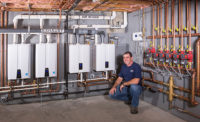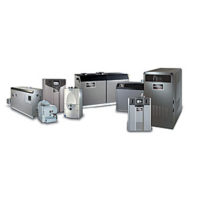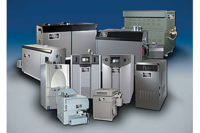Water heaters face 2015 mandate
What the DOE’s new efficiency standards mean for you and your customers.

Takagi’s new High-Efficiency Condensing Ultra Low-NOx tankless water heaters have an Energy Factor of 0.95. The 2015 energy-efficiency requirements call for an EF of 0.82 for gas-fired tankless models. Photo courtesy of Takagi

Rheem recently introduced its High-Efficiency Condensing Power Direct Vent water heater for the residential market. In 38-gal. and 48- gal. capacities, the water heater has an Energy Factor of 0.80, well above the 2015 requirement of 0.62 for storage water heaters under 55 gal. Photo courtesy of Rheem

Water heater models such as Bradford White’s TTW Power Vent High EF and Atmospheric Vent High EF (pictured) gas water heaters are already in compliance with the 2015 DOE requirements. “Many of the water heater products we know today, however, will significantly change by the time the new requirements take effect,” says R. Bruce Carnevale, Bradford White’s executive vice president of sales and marketing. Photo courtesy of Bradford White.



In April 2010, the U.S. Department of Energy issued new efficiency standards for residential storage water heaters — gas-fired, oil-fired and electric — and gas-fired tankless water heaters. These efficiency standards become effective in April 2015.
The current efficiency standards for gas-fired storage units require an Energy Factor of 0.59. The new standards will require gas-fired water heaters less than 55 gal. to have an EF of 0.62 and gas-fired units more than 55 gal. to have an EF of 0.76. For electric storage, standards will increase from the current 0.90 EF to 0.95 for units less than 55 gal. and 2.00 for units more than 55 gal.
Efficiency standards for oil-fired storage water heaters will increase from the current EF of 0.53 to 0.62. And gas-fired tankless water heaters will go from an EF of 0.62 to 0.82.
Energy Factor is defined as the measure of overall efficiency for a variety of appliances. For water heaters, the EF is based on three factors: the recovery efficiency, or how efficiently the heat from the energy source is transferred to the water; stand-by losses, or the percentage of heat lost per hour from the stored water compared to the content of the water; and cycling losses.
“By raising the energy-efficiency requirements of our everyday appliances, we will save money for American families and companies, reduce carbon pollution and enhance our energy security for decades to come,” DOE Secretary Steven Chu said in announcing the new requirements. The DOE notes the new requirements will decrease energy usage in large electic water heaters by 47% and by more than 30% in large gas water heaters.
“Residential water heating is often the second largest energy use in the home and can account for up to a quarter of overall energy consumption,” says Bridget Scanlon, director of residential and commercial programs for the Propane Education & Research Council. “More efficient systems offer options for contractors and homeowners to meet demands for comfort while mitigating their total energy cost and consumption.
“With so much money being funneled into inefficient water heating systems, it is critical for contractors to assist homeowners with selecting an efficient system in the early stages of home building or when replacing an older unit. By choosing an on-demand system such as a propane-fueled tankless water heater instead of a standard electric water heater, homeowners can reduce energy costs by up to 50% and reduce greenhouse gas emissions by up to 61%.”
Essentially, the new requirements will require water heater manufacturers to use more advanced technologies such as heat pump and condensing technology to increase energy efficiency. The Air-Conditioning, Heating and Refrigeration Institute stated that these technologies were “too expensive and not ready for widespread deployment,” the New York Times reports.
“In the long run, a shift to electric heat pump and condensing gas water heaters is absolutely essential if we are to make deep cuts in household energy use and costs,” counters Jeffrey Harris, vice president of national programs, Alliance to Save Energy.
To meet the amended standards, the DOE estimates the average installed price of such equipment will increase by $120, which will be offset by savings of $143 over the life of the equipment. A 55-plus gal. gas water heater would have a median payback of 9.8 years, an electric water heater would have a 6-year payback, an oil-fired model would have a 6-month payback and gas-fired tankless would have a payback of 14.8 years.
Practical matters
The new water heater requirements do not mean that consumers have to replace their water heaters in 2015. Like the low-flow toilet requirements of the early 1990s, the DOE mandate means that manufacturers cannot produce or sell lower-efficient water heaters after April 15, 2015. Wholesalers will still be able to sell product in their warehouses until their inventory is gone.
At last year’s Plumbing-Heating-Cooling Contractors — National Association’s convention, PHCC Connect 2012 in Philadelphia, Charles Smith of Bradford White Corp. spoke to contractors about the new water heater requirements. Manufacturers continue to work on designs incorporating condensing and heat pump technology without making them cost-prohibitive to consumers.
Practical considerations that will need to be addressed concerning the condensing and heat pump water heaters have much to do with the size of the water heaters, he said. Space considerations pose more questions during the installation in a customer’s home, mostly for repair and maintenance issues.
Smith encouraged plumbing and heating contractors to get familiar with the new requirements so they can provide their customers accurate information on new water heater models and what technology and fuel source will work best in their homes. Factory training, on-site training and webinars are great ways for contractors to obtain the knowledge they need to deal with the practical matters of the 2015 requirements.
“It is vitally important for manufacturers, wholesalers and contractors alike to stay on top of the 2015 DOE requirements affecting water heaters,” says R. Bruce Carnevale, Bradford White’s executive vice president of sales and marketing. “The new regulations will have a significant impact on many of the products we know today. Bradford White is committed to helping our customers and business partners prepare for the new standards well ahead of the requirement. The time to learn, train and prepare is now.”
Note: This article originally appeared in Supply House Times’ sister publication Plumbing & Mechanical.
HELPFUL LINKS:
Looking for a reprint of this article?
From high-res PDFs to custom plaques, order your copy today!









